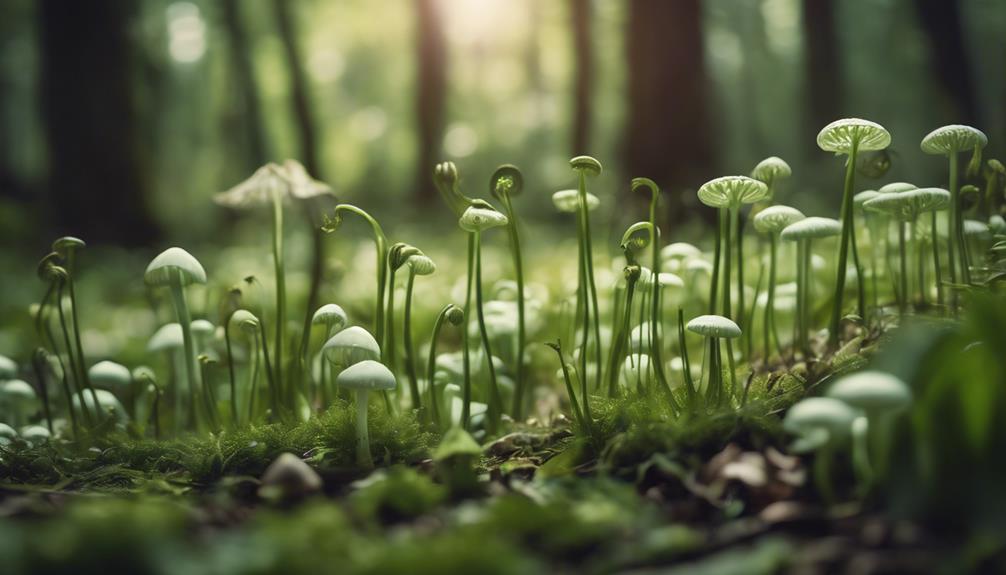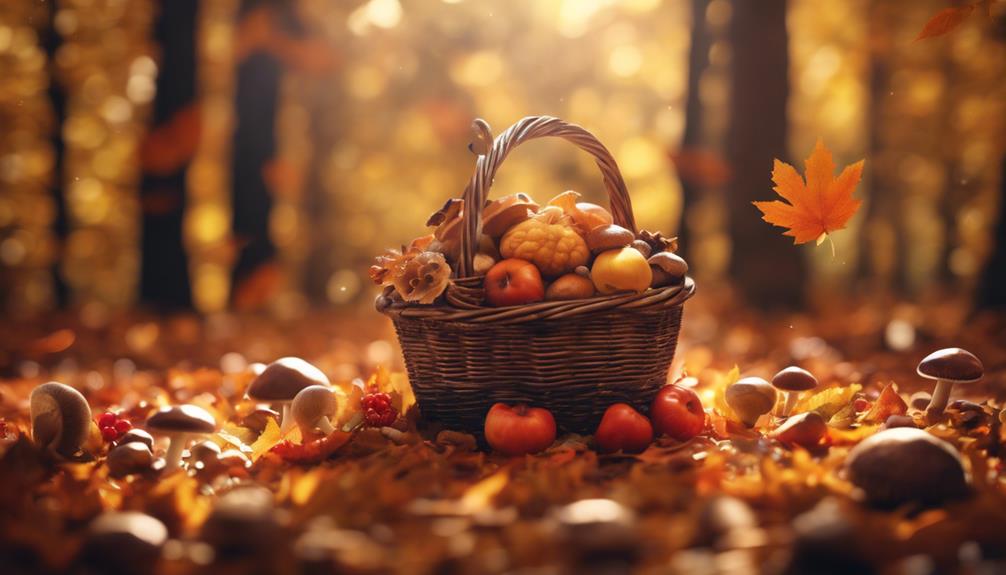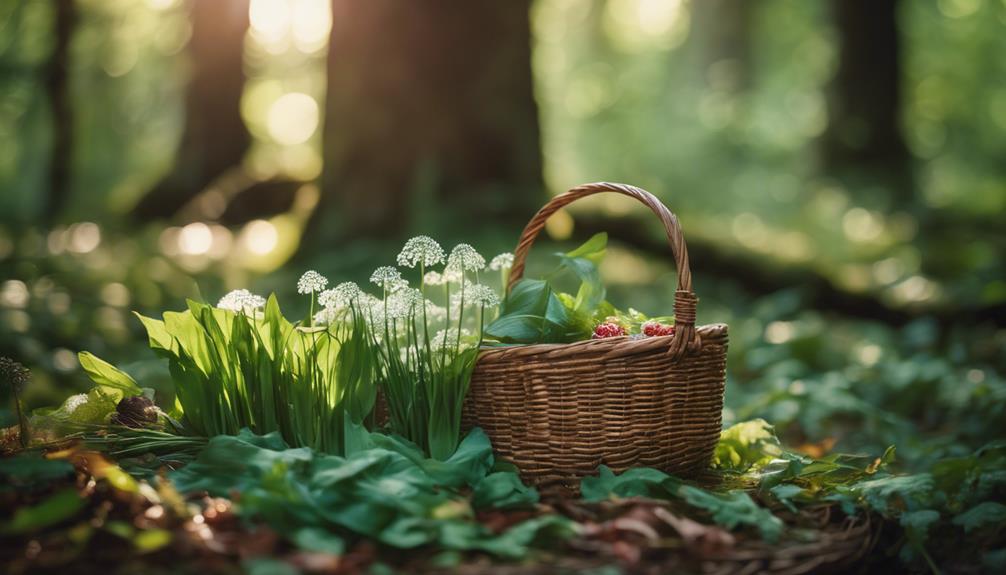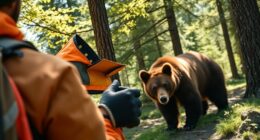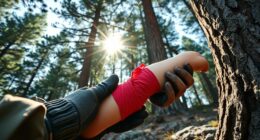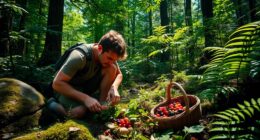Foraging for desert plants is an exciting adventure that lets you explore delicious, wild flavors. You'll find tasty options like prickly pear and mesquite pods, perfect for adding to your meals. To get started, it's important to know how to identify these plants safely and recognize which are edible. Always remember to pick responsibly, taking only what you need, and be sure to check local laws about foraging. Wild foods are packed with nutrients, making them great for your health! There's a lot more to discover about this fun activity that can enhance your outdoor experiences!
Key Takeaways
- Identify common desert plants like prickly pear and mesquite, which offer nutritious food options and unique culinary uses.
- Use reliable field guides or apps for accurate identification and to distinguish edible plants from toxic look-alikes.
- Forage responsibly by taking only what you need and ensuring enough plants remain for ecosystem balance.
- Be aware of local foraging laws and regulations, especially concerning protected areas and private property.
- Participate in community events or workshops to enhance your foraging knowledge and skills while connecting with others.
Historical Significance of Foraging

Foraging has always played a crucial role in human survival, shaping our diets long before agriculture took root. Imagine wandering the desert, discovering wild edibles that have nourished people for thousands of years!
Many Native Americans were experts at this, using the diverse plants around them to create delicious meals. They knew which plants to eat and how to prepare them, helping their communities thrive in challenging environments. Proper diet practices, such as incorporating wild edibles, can enhance nutrition and food diversity. Additionally, foraging can foster a deeper connection to the land and promote awareness of local ecosystems. In many cultures, including Indonesia, the use of traditional techniques in crafting is a testament to the importance of preserving heritage.
After World War II, people started to forget about foraging as industrial agriculture took over. Pesticides and mass-produced food became the norm, pushing aside those tasty wild foods.
But now, there's a growing interest in these natural treasures, like stinging nettle and prickly pear. These plants aren't just yummy; they're packed with nutrients too! Understanding the nutritional benefits of these wild edibles can help individuals make healthier dietary choices.
In desert foraging, you can find powerful flavors and benefits. Even in dry areas where farming might be tough, wild edibles can be a fantastic source of food. These plants can provide essential vitamins and minerals that are often lacking in processed diets.
Key Desert Plants to Forage

Exploring the desert landscape reveals a bounty of edible plants that have sustained humans for generations. One of the most exciting finds is the prickly pear cactus. You can eat both the pads, called nopales, and the sweet fruits, which are packed with vitamins A and C. They're great in syrups and candies! Additionally, prickly pear has been known to support immune system function through its nutritious properties. Educational toys can help develop skills in young children, much like how foraging can enhance survival skills.
Another treasure is chia sage. The tiny seeds are super nutritious, giving you energy and essential fatty acids. Plus, they're related to the trendy health food chia! Chia seeds are also a complete protein source, making them a valuable addition to your foraged diet. These seeds are an excellent way to boost your omega-3 intake in a plant-based diet.
Don't forget about mesquite! Its bean-like pods can be ground into flour, making a traditional food source that's high in protein and carbohydrates.
Agave is also a fun plant to forage. Its leaves, flowers, and seeds are edible, plus you can use it for craft fibers.
Lastly, the pinyon pine tree offers delicious pine nuts, which are rich in calories, and its pitch can be used for making primitive adhesives. For a well-rounded diet, consider incorporating complete protein sources from foraged plants alongside your meals.
These Sonoran desert plants are just a few examples of wild food waiting to be discovered. So, grab your foraging gear and get ready for a tasty adventure in the desert!
Identifying Edible Flora

When you're out exploring the desert, spotting edible plants like prickly pear and cholla can feel like a treasure hunt! Remember, some plants can look similar but aren't safe to eat, so always check your field guide or plant app to be sure. The more you learn about the unique features of these plants, like their thorns and tasty fruits, the more confident you'll feel as a forager! Understanding seasonal growth patterns can significantly enhance your foraging success. Additionally, knowing the safe materials used in crafting foraging tools can enhance your overall experience and safety. Pollination efficiency is also influenced by the availability of these edible plants, making it important to be aware of local bee populations. Incorporating nutritious forage mixes into your diet can also improve your overall health and well-being. It's also beneficial to include high-calorie options in your foraging plans to ensure you maintain energy during your adventures.
Key Identification Techniques
Identifying edible flora requires keen observation and a methodical approach. Start by getting to know one easily recognizable edible plant, like the prickly pear. It's a fun way to build your confidence and improve your identification ability.
Grab a reliable field guidebook or a helpful app that shows pictures and descriptions of wild edible plants. These resources make it easier to spot the differences between edible plants and their look-alikes. Additionally, understanding the local ecosystems can help you identify which plants are more likely to thrive in your area. In your search, consider the water requirements of various plants, as this can influence their availability and health. Engaging with the environment during foraging can also enhance your cognitive skills by challenging your ability to recognize and differentiate between species. Curiosity can significantly enhance your problem-solving abilities, making you more adept at identifying various plants.
When you're out foraging, pay close attention to the plant's habitat, leaf shape, flower color, and growth patterns. These details are your best friends for accurate identification!
Remember to harvest your plants away from roads and industrial areas to keep them safe from pollution. You want your wild food to be as clean as possible!
Also, don't forget to check the seasonal availability of plants. Some edible species are only safe to eat during certain times of the year. So, keep a little calendar in mind! Additionally, learning about cultural origins of foraging baskets can enhance your understanding of the historical context of foraging practices.
With practice and patience, you'll become an expert at finding delicious edible plants in no time! Happy foraging!
Toxic Look-Alike Awareness
Consistently being aware of toxic look-alikes is essential for safe foraging. As you explore the desert, remember that some tasty plants can be tricky to identify. Here's a handy table to help you recognize a few common edible plants and their toxic look-alikes:
| Edible Plant | Toxic Look-Alike | Key Identification Tip |
|---|---|---|
| Wild Carrot | Poisonous Hemlock | Wild carrot has a hairy stem. |
| Stinging Nettle | Non-Edible Nettle | Edible nettle has pointed leaves. |
| Blackberry | Toxic Nightshade | Blackberries have thorny stems. |
Proper identification is vital, so always double-check with reliable foraging guides or experts. When you start with easy-to-recognize plants, you'll build confidence for more complex ones later. Additionally, maintaining a growth mindset can help you adapt your foraging skills as you learn more about the flora. Remember that some plants, like cotton candy grapes, can be a delightful treat while foraging. Incorporating a portable air purifier can enhance your foraging experience by ensuring you breathe cleaner air while outdoors. Be mindful that some plants, like tea tree oil, can have antibacterial properties that may be beneficial for minor cuts or scrapes you encounter while foraging. Also, avoid foraging near roads or industrial areas; you want to stick to healthy ecosystems. This way, you'll enjoy safe and delicious foraging adventures! Remember, having a well-packed bug out bag can ensure you're prepared for any unexpected situations while foraging. Happy exploring!
Safety Precautions in Foraging

When you're out foraging, it's super important to know how to identify plants correctly, so you don't accidentally pick something harmful. Always check your guidebooks or apps to spot the delicious and safe plants, and remember to harvest responsibly, leaving plenty for nature. Additionally, be aware that some plants can be toxic to pets, similar to how grapes are toxic to dogs, so ensure a safe environment for your furry friends while foraging. For instance, certain flowers like chrysanthemums contain pyrethrins, which are harmful to dogs and can cause serious health issues if ingested. Furthermore, just as with VA rating criteria for hearing loss in veterans, understanding the characteristics of various plants is vital to ensure your foraging efforts are safe and beneficial. Maintaining awareness of plant toxicity levels can help prevent accidental ingestion of harmful species. Additionally, some edible plants may also have nutritional deficiencies that could impact your health if consumed in excess.
Plant Identification Techniques
Foraging safely starts with knowing how to correctly identify plants, and it's crucial to take your time with this process.
Begin by finding one easily recognizable plant, perhaps with the help of an experienced guide or a reliable guidebook. This builds your confidence and keeps you safe! Global inflation rates can affect the availability of certain plants, so it's wise to stay informed about local market trends while foraging. It's also beneficial to understand the emotional well-being of your environment, as it can influence your foraging experience. Additionally, you might consider incorporating seasonal plants into your diet to enhance nutrition and flavor.
Use plant identification techniques to figure out which parts of the plant are edible. Always be on the lookout for toxic look-alikes. If you're not 100% sure about a plant, don't eat it! It's much better to be cautious than sorry.
When foraging, stick to areas far away from roads and industrial sites to avoid pollutants.
Focus on consuming plants during their seasonal availability for the best taste and safety. Additionally, ensure you're aware of your surroundings to avoid potential hazards, similar to understanding common toilet issues that can impede safety and enjoyment.
Keeping a foraging journal is a fun way to document your findings. Write down your plant identification notes and any personal experiences. This helps you remember what you've learned and makes you a better forager over time.
By taking these steps, you'll enjoy your foraging adventures while staying safe and happy!
Harvesting Responsibly
Responsible harvesting is essential to guarantee that foraging remains sustainable and safe. When you're out exploring for wild foods, always start with an experienced guide. They'll help you accurately identify edible plants, so you don't accidentally pick something harmful. Additionally, understanding key elements of a successful co-parenting plan can help you manage your time effectively when planning foraging trips around family commitments.
Make sure to forage in clean areas, away from roads. This way, you can dodge pollution from pesticides and car fumes! Engaging in foraging can also enhance your mental wellbeing, providing a sense of connection to nature and promoting relaxation, similar to how essential oils can aid in emotional balance.
It's also important to know the seasons. Some plants are only available at certain times, and proper identification is key to enjoying safe edible uses.
When you're harvesting responsibly, take only what you need. Leave enough plants behind to grow again, which helps support local ecosystems and wildlife.
Before you head out, check local laws about foraging. Some areas have rules that protect plants, especially in parks or private property. Additionally, understanding the importance of sustainable foraging practices can enhance your experience and ensure you're contributing positively to the environment.
By following these guidelines, you can enjoy the adventure of foraging while being kind to nature. It's all about finding that balance!
Avoiding Toxic Look-Alikes
Exploring the world of wild edibles can be thrilling, but it also comes with risks, especially when it comes to toxic look-alikes. Many plants that seem harmless can be dangerous, and you don't want to mistake a toxic plant for a food resource! Always check a reliable field guide or app to help you accurately identify plants before foraging.
Start by learning the key features of both edible plants and their toxic cousins. Pay attention to leaf shape, flower color, and growth patterns. This knowledge helps you avoid confusion while out in nature. Conducting thorough research, much like the way employers perform background checks before hiring, can significantly enhance your safety while foraging. Additionally, understanding the importance of environmental sustainability can assist you in recognizing which plants thrive in healthy ecosystems. The Hopi Tribe, for example, has a deep understanding of ancestral knowledge concerning local flora that can guide safe foraging practices. A focus on sustainable living practices can also support your efforts in responsible foraging and preservation of local habitats.
Foraging away from roads and industrial sites is important too, as some toxic plants can soak up harmful pollutants from the ground.
A great way to build your confidence is to practice the "one plant rule." Pick one easy-to-recognize edible plant and stick with it until you feel comfortable.
You can also join foraging workshops or guided walks to learn from experienced foragers. They'll show you how to distinguish safe plants from those you want to avoid, making your adventure in foraging both fun and safe! Happy foraging! Understanding the importance of environmental factors can further enhance your foraging knowledge and safety practices.
Nutritional Benefits of Wild Foods

Discovering the nutritional benefits of wild foods can transform your diet and enhance your well-being. For example, prickly pear is a tasty desert food that's packed with pectin. This special fiber can help lower bad cholesterol and reduce insulin needs for diabetics. Isn't that amazing?
When you forage for wild plants, you often find they've more nutrients than store-bought fruits and veggies. They're rich in essential vitamins, minerals, protein, and fiber, making them more nutritious than conventional options.
Plus, many wild foods, like certain medicinal plants, are known to contain cancer-fighting compounds. That means you're not just eating; you're nourishing your body in a powerful way!
Eating a variety of desert foods keeps your meals exciting and supports your health too. It can lower the risk of chronic diseases and even help you feel better overall. Moreover, foraging helps you consume more nutrient-dense foods that can contribute to a balanced diet.
Plus, foraging gets you moving outside, connecting you with nature and improving your mental well-being.
Practical Foraging Techniques

Foraging for wild foods can be an exciting way to enhance your diet, but knowing how to do it safely and effectively is essential. Start by using plant identification guides or mobile apps to help you recognize edible desert plants.
It's vital to avoid toxic look-alikes, especially since many wild plants may look similar in a desert setting. Focus on easily recognizable plants at first, which will help you build confidence and knowledge over time.
When you're out foraging, remember to harvest responsibly. Leave enough plants for regeneration and wildlife, and try to forage away from roads to keep your finds clean and safe.
Keeping a foraging journal is a great idea! Write down your findings, experiences, and recipes. This will help you track the seasonal availability of different plants and enhance your learning.
Tools Made From Desert Plants

While you're out in the desert gathering food, don't overlook the incredible tools you can make from the plants around you. Desert plants aren't just a source of nourishment; they can also help you create handy tools for survival!
For example, the strong fibers from yucca plants can be woven into cordage or baskets. You can even make mats to sit on while enjoying your meal.
Juniper trees provide tough wood that's perfect for crafting fire-making tools or even hunting bows. How cool is that?
Plus, mesquite trees have bean-like pods that can be ground into flour, which you can use to make tasty treats.
Don't forget about pinyon pine trees! They give you delicious pine nuts that are rich in calories. You can eat them as a snack or grind them into meal for cooking.
Agave plants are super helpful too; their leaves can turn into fibers for textiles, while the flowers and seeds offer even more food options.
Legal Aspects of Foraging

Before you start foraging for those delicious desert plants, it's super important to know the rules!
Each state has its own laws, like how California keeps fruit collection far from roads to keep everyone safe.
Plus, remember to always ask permission if you're on private land, because respecting nature and others is what makes foraging fun and responsible!
Local Foraging Regulations
Maneuvering local foraging regulations is essential for anyone looking to collect plants in the wild. Knowing the rules helps you stay safe and enjoy your foraging adventures!
In California, for example, you can't forage within 100 yards of roads or highways, and you must ask for permission before picking plants on private property.
It's also important to learn about foraging regulations in protected areas, like national parks. These places often have strict rules against foraging. If you don't follow them, you could face fines or even legal trouble!
In many states, you might need a permit to collect certain plants, especially if they're rare or endangered.
Plus, remember that local laws can differ, especially in urban areas. Some cities have unique restrictions on plant collection, so it's good to check before you start.
Protected Areas Restrictions
Foraging in protected areas presents unique challenges and rules that you must navigate carefully.
These special places, like national parks and wildlife reserves, help keep our ecosystems safe. To enjoy foraging activities without trouble, here are some important tips to remember: When engaging in coastal foraging, it is essential to research local regulations and guidelines to ensure that you are not damaging the environment or endangering any protected species. Always be mindful of the fragile ecosystems along the coast and practice sustainable foraging techniques to help preserve these unique environments for future generations. Additionally, consider joining organized coastal foraging tours or groups led by knowledgeable guides who can provide valuable insights and ensure that foraging activities are conducted responsibly.
- Check Regulations: Always look up the specific rules for foraging in your local protected areas. They can change based on location.
- Get a Permit: Many areas require permits for foraging. Don't skip this step, or you might face fines!
- Stay Away from Roads: In California, it's illegal to collect plants or fruits within 100 yards of roads without permission. That's a big no-no!
- Contact Local Agencies: Reach out to local land management agencies for the latest updates on foraging rules.
Private Property Guidelines
Maneuvering the legal aspects of foraging on private property is essential for a successful and trouble-free experience. You can find amazing plants, but it's vital to respect landowners and their space. Always ask for permission before you start foraging on private property. If you don't, you could face trespassing charges, which isn't fun at all!
Understanding local laws is just as important. These laws can change depending on where you live. For example, in California, you can't collect fruit within 100 yards of a road.
Here's a quick reference table to help you remember:
| Action | Guideline |
|---|---|
| Ask for Permission | Always get consent from landowners. |
| Know Your Local Laws | Check regulations specific to your area. |
| Respect Boundaries | Stay within marked property lines. |
| Avoid Disruption | Don't harm local ecosystems or wildlife. |
Sustainable Harvesting Practices

As you explore the desert landscape, it's vital to adopt sustainable harvesting practices that guarantee the longevity of plant species and their ecosystems.
Foraging in the Sonoran Desert can be delightful, but it's important to do it responsibly. Here are some simple tips to keep in mind:
- Take Only What You Need: Collect just enough for your needs and leave plenty behind for the plants to regenerate.
- Know the Seasons: Learn about the reproductive cycles of plants and harvest them during their peak seasons when they can bounce back quickly.
- Leave No Trace: Be careful not to damage other plants and animals around you. Your goal is to maintain the delicate balance of nature.
- Follow the Rules: Always check local guidelines and regulations. Some areas are protected, and it's vital to respect those rules.
Educational Resources for Foragers

To deepen your understanding of desert foraging, you'll find a wealth of educational resources at your fingertips. Start with the "Desert Wild Edibles List," a handy guide that helps you identify and use edible desert plants. This list is perfect for beginners and seasoned foragers alike!
For an exciting read, check out "How Indians Used Desert Plants" and "50 Common Edible & Useful Plants of the Southwest." These books delve into the traditional uses of plants and show you their many benefits.
If you prefer hands-on learning, consider enrolling in courses like Wild Edible & Medicinal Plants or Wilderness Survival. These classes teach valuable foraging techniques and plant identification skills.
Don't forget to explore free online resources! A survival mini guide can give you essential tips for safe foraging in the desert.
Plus, subscribing to monthly newsletters keeps you updated on wilderness skills and foraging opportunities. You'll learn about fun community events that enhance your foraging journey.
With these educational resources, you'll feel more confident exploring the desert and discovering its amazing plants. Happy foraging!
Frequently Asked Questions
Can You Forage in the Desert?
Yes, you can definitely forage in the desert! It's like a treasure hunt for tasty plants.
You'll find prickly pear, cholla cactus, and saguaro, all packed with yummy flavors and nutrients.
Just remember, it's super important to know which plants are safe to eat because some can be tricky. Plus, always check local rules so you're foraging responsibly.
It's a fun way to explore nature and discover delicious snacks! Enjoy the adventure!
What Is the Number One Rule of Foraging?
Did you know that over 100,000 people get sick each year from eating wild plants?
That's why the number one rule of foraging is to accurately identify plants before munching on them!
You've gotta be sure they're safe, or you might face some big tummy troubles.
So, grab a guidebook or go with someone who knows their plants.
It's a fun adventure, and you'll learn so much while enjoying nature!
Can You Take Plants From the Desert?
You can't just take plants from the desert, and here's why!
Many areas have rules to protect nature, like national parks where you need special permits. If you pick plants from private land, you'll need permission from the owner.
Plus, some places don't allow foraging near roads to keep both the plants and animals safe.
Always check local laws so you can enjoy the desert while respecting its beautiful ecosystem!
Can You Eat Plants in the Desert?
Yes, you can eat plants in the desert, but you need to be careful!
Some tasty options like prickly pear and mesquite are full of nutrients and can be enjoyed in different ways.
Just remember, always ask an expert before munching on any plant.
Look for the bright colors and unique shapes that signal edible treats!
With a little knowledge, you can discover a whole world of delicious desert snacks waiting for you!
Conclusion
So, grab your backpack, a hat, and some water, and head out to explore the wonderful world of desert foraging! Picture yourself picking juicy prickly pears or sniffing fragrant desert sage. Each plant tells a story, and you're part of it! Remember to be safe, respect nature, and share your tasty discoveries with friends. Foraging isn't just about finding food; it's about connecting with the earth and having fun along the way. Happy foraging!



